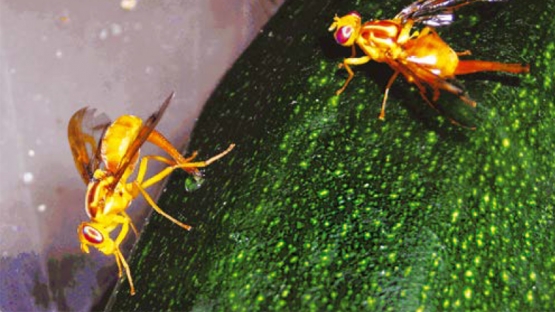Getting to know members of the Tephritid family can be quite a colourful experience. Tephritidae is the family name of fruit flies, one of the most damaging insect pests of horticultural products worldwide. Over the centuries, taxonomists have broken the Tephritidae into some 500 genuses and then further into 5000 species – most of which have colourful wings, interesting mating rituals and territorial personalities. But today, for some species of economic and quarantine importance, questions arise as to whether taxonomists have been correct in how they have identified the species – whether they are actually distinct biological species or variants of the same species. The Joint FAO/IAEA Division conducted coordinated research aimed at resolving some of the taxonomic questions surrounding major “cryptic” species complexes, meaning questions about closely related species within a genus. The study led to accurate taxonomic alignment of the species and provided valuable information needed for effective application of the sterile insect technology (SIT) and facilitation of international trade.
This is the story of three fruit fly complexes and a suspected complex of significant economic importance. These pests, all of which can cause major yield losses and by their very presence keep a horticultural sector from exporting, are known scientifically as Anastrepha fraterculus (South American fruit fly complex), Bactrocera dorsalis (Oriental fruit fly complex), Ceratitis FAR (fruit fly complex from the African region), and Zeugodacus cucurbitae (formerly Bactrocera cucurbitae ), the melon fly suspected complex.
Accurate fruit fly taxonomy makes it possible to assess which species are present or absent in a given area which, in turn, provides a scientific basis for countries to set up their import regulations according to international phytosanitary standards, and to develop appropriate and effective fruit fly surveillance and control methods. For example, using the sterile insect technique (SIT), a species- specific and cost-effective environmentally friendly method of controlling fruit flies, requires a substantial initial capital investment. Thus, before embarking on such an endeavour, it is essential for governments and industry to know exactly which species are present in the area of interest.
For example, over the years, taxonomists identified and named several closely related species of Bactrocera dorsalis, to a point where it became the “dorsalis complex”. The Bactrocera species are native to Southeast Asia, but when one of its species arrived in East Africa from Sri Lanka in 2003, taxonomists identified it as a new species, naming it “B. invadens” because it spread quickly and aggressively across more than ten African countries. In response, regulatory authorities of importing countries required exporters from the African countries to certify that their horticultural produce originated from B. invadens- free areas or that the produce was free of the pest – but this required stringent post-harvest treatments that were not readily available for this supposedly new species. As a result, the exporting African countries dealt with years of trade restrictions that seriously affected their mango and banana exports.
The Joint Division, with participating scientists from 20 countries, decided to take another look at the fruit fly complexes, including the case of B. invadens and other suspected species. With the availability of new, more precise tools to identify species, the scientists began the processes of comparing morphology, e.g. of wings, antennae and organs; checking at the genetic level for consistency; and checking propensity for mating compatibility, all of which are accepted designations for identifying species.





